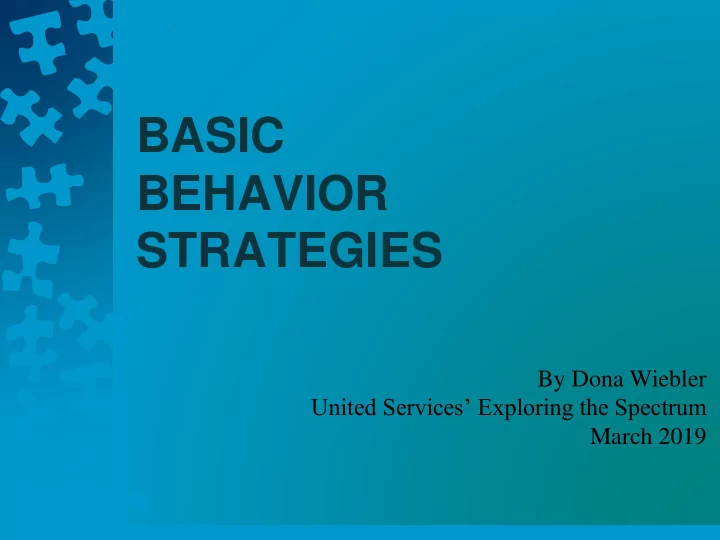

BASIC BEHAVIOR STRATEGIES By Dona Wiebler United Services’ Exploring the Spectrum March 2019
WHAT IS “BEHAVIOR”? • A response to the environment • Should be seen as neither good nor bad • A way of getting a need met • Audience adds connotation of “good” or “bad” • Must change the environment to change the behavior
WHY YOU DO THOSE THINGS YOU DO…. Antecedent Behavior Consequence (ABCs) B = what the person did A = what happened immediately before C = what happened immediately after A & C are not always clear. Sometimes, you have to REALLY think about it.
EVERY BEHAVIOR SERVES A FUNCTION Sensory ● Space, touch, sound, light, temperature, smell, postural instability Communication ● Get something: attention, activity, item ● Get away from something: person, activity, area
Reinforcement vs Punishment vs Bribery • Reinforcement is given afterward to increase a wanted behavior. • Punishment decreases an unwanted behavior. • Bribery is given while behavior is happening to stop it. • We all work for reinforcement. • Punishment works….for now. • Reinforcement works for longer.
STAGES OF AROUSAL: Building up to the explosion 1. Anxiety Change in behavior • 2. Defensiveness Beginning to lose rationality; challenging, • questioning 3. Aggression Physically acting out • 4. Calming Return to rationality; decrease in energy • Crisis Prevention Institute Principles of Non-Violent Crisis Prevention Intervention
MEETING THE CHILD WHERE THEY ARE: Trying to avoid or manage the explosion 1.Anxious • Empathy and support to destress the situation 2.Defensive • Set reasonable limits and stick to them 3.Aggressive • Keep everyone safe — yourself, others, the child 4.Calming • re-establish the relationship Crisis Prevention Institute Principles of Non-Violent Crisis Prevention Intervention
FIRST STEP--PLANNING FOR THOSE “MOMENTS”: What is your goal? What needs to happen? • Is this a preferred activity for the child? No? Then “why • should I?” What sort of preparation have you done to let the child • know what the expectations are? Rules & Rewards Have you answered the question “why should I?” Do you • have the right reinforcement? Are there sensory issues that need to be addressed? • Do you have visual supports?** (see end of slides ) • Have you taught the expectations when the child is calm? • Do you have an idea of what else you can “live with” if the • goal needs to change?
WHEN YOU’RE IN THE MIDDLE OF A MELTDOWN: • Safety first, everything else is second. • Practice staying calm. You don’t want a game of “I can top that .” (Stages of Arousal) • Limit touch & talk. Don’t push more “bees into the hive .” • What is your goal in that moment? May require of switching of roles between adults, or a switching of expectations. • Don’t try to teach anything. Nobody’s listening . Be sure you have visuals to use. Don’t rely on words. • “When you’re ready…..” “Ready means: sitting, quiet voice, hands to self. Are you ready?” • Once everyone is calm & ready, don’t ask “why.” Try instead for “what should we do next time?” Review the rules, expectations, and schedules.
THINGS TO THINK ABOUT WHILE YOU’RE WAITING FOR THE MOMENT TO PASS: What is the child “saying”? • Is there a“thing” I can use to move the child rather • than moving the child, himself? What would the child be willing to work for? • Can we take a moment to just chill for a bit, to let • the hive calm down? What words are absolutely necessary? What • words are just adding “bees?” Is this a battle that really needs to be fought right • now?
STOP IS NOT AN OPTION. You will never stop a behavior. • You can replace behaviors. • You must change the environment to change • the behavior. How often is it the adult who must do the changing? 100% of the time. “If you keep doing what you’re doing, you’ll keep getting what you got.” If we find it so hard to change our behavior, how must our kids feel?
IS IT WORKING? • Habits are not broken in 1-2 days; it takes an average of 66 days to establish a new habit. • Consistency is key. Or, let me tell you about the lottery…. • Behavior usually gets worse before it gets better: why doesn’t this work anymore ?? “Well….there’s this vending machine…” • May need to reassess function if there’s no change at all.
All Time Favorites
VISUALS ARE YOUR FRIEND 1. oranges 2. hot dogs 3. cereal 4. apple juice 5. candy bar
RESOURCES • Baker, James E. (2008). No More Meltdowns. Arlington, TX: Future Horizons, Inc. • Dickinson, Paul, & Hannah, Liz. (1998). It Can Get Better. London, UK: The National Autistic Society. • Quill, Kathleen Ann. (2005). Do-Watch-Listen-Say: Social and Communication Intervention for Children with Autism. Baltimore, MD: Paul H. Brooks Publishing • Leaf, Ron, and McEachin, J. (1999). A work in progress: behavior management strategies and a curriculum for intensive behavioral treatment of autism. New York, NY: DRL Books, Inc. • Maurice C, Green G. Luce SC. (1996). Behavioral intervention for young children with Autism. Austin: Pro- Ed. • https://www.crisisprevention.com/Featured-Resources
Recommend
More recommend